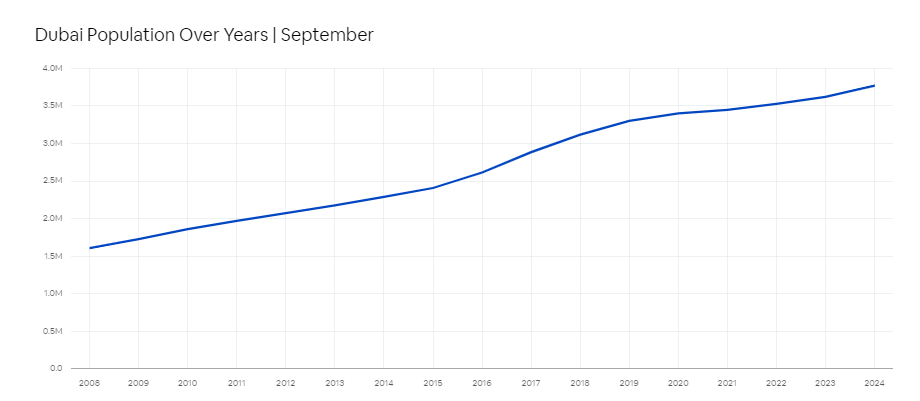
Dubai has established itself as a global hub for tourism, business, and residence, and this is reflected in its population growth over the past 14 years. From 1.86 million residents in 2010 to an impressive 3.77 million in 2024, the city has demonstrated a steady rise in its appeal to both expatriates and local citizens. Let’s break down the key aspects of this growth trend and its implications for Dubai’s future.

1. Overall Growth Trend
Dubai’s population has grown significantly since 2010. Starting at 1.86 million in that year, it reached 3.77 million in 2024—a staggering 102% increase in just 14 years. This growth highlights the city’s ability to attract people from all over the world, driven by its economic opportunities, infrastructural advancements, and favorable lifestyle conditions.
2. Rate of Growth
While Dubai’s population has consistently grown, the rate of this growth has fluctuated over the years.
- From 2017 to 2018, the city experienced some of its highest annual growth rates, with increases of 10.36% and 8.09%, respectively.
- However, post-2018, the growth rate started slowing down, with 2021 marking a particularly low growth rate of just 1.34%.
- Despite this deceleration, 2024 has seen a slight resurgence in growth at 4.11%, indicating a potential recovery in population influx, possibly linked to policy changes, new investments, or the global post-pandemic recovery.
3. Significant High Growth Periods
Between 2017 and 2018, Dubai saw its most substantial population increase, likely due to several factors. These include large-scale infrastructure and developmental projects (e.g., Dubai Expo preparations) and an influx of expatriates drawn by economic opportunities, especially in real estate, finance, and tourism. During this period, the city’s population grew by over 500,000 people in just two years, reflecting Dubai’s booming economy and its attractiveness as a global city.
4. Recent Deceleration
From 2021 onwards, there was a marked deceleration in population growth. This can be attributed to global factors like the COVID-19 pandemic, which disrupted migration patterns worldwide, with many expatriates leaving or delaying their move to Dubai, and economic adjustments post-pandemic that affected hiring and investment, particularly in sectors reliant on global mobility. Despite these challenges, Dubai has continued to grow, though at a slower rate compared to the pre-pandemic period. The slight uptick in growth in 2024 indicates the city is bouncing back, signaling renewed confidence in its economic prospects.
5. Future Trends
The increase in the growth rate from 2.66% in 2023 to 4.11% in 2024 suggests that Dubai may be entering a new growth phase. This uptick could be influenced by policy changes, such as initiatives to attract skilled professionals (like the golden visa), and new infrastructure projects, ongoing developments in transportation, housing, and tourism infrastructure, which are expected to draw more residents and investors. Dubai’s future population trajectory is likely to remain positive, especially if global and regional economic conditions remain favorable.
6. Implications for Planning and Services
The steady population growth places increased demand on the city’s infrastructure and services. Key areas that will need continued focus include urban development (expansion of housing projects, commercial spaces, and utilities to accommodate the growing population), healthcare and education (which will need to scale up significantly to meet the needs of both local citizens and expatriates), and transportation (Dubai’s roads, metro systems, and airports will need to handle the pressure of an expanding populace, ensuring efficient mobility throughout the city).
7. Economic and Social Dynamics
Dubai’s population growth has a direct impact on its economy. Higher growth periods often correlate with economic booms, large-scale infrastructure projects, and an influx of foreign investment. Conversely, periods of slower growth may reflect global downturns, such as during the COVID-19 pandemic. As Dubai continues to evolve as a global city, its population dynamics will remain a critical indicator of the city’s broader economic and social trends.
Dubai's Population Growth (2010-2024)
| Year | Population | Annual Growth Rate | Population Change (K) |
|---|
| 2024 | 3.77 M | 4.11% | 148.86 K |
| 2023 | 3.62 M | 2.66% | 93.85 K |
| 2022 | 3.53 M | 2.34% | 80.56 K |
| 2021 | 3.45 M | 1.34% | 45.49 K |
| 2020 | 3.4 M | 3.03% | 100.03 K |
| 2019 | 3.3 M | 5.88% | 183.31 K |
| 2018 | 3.12 M | 8.09% | 233.19 K |
| 2017 | 2.88 M | 10.36% | 270.62 K |
| 2016 | 2.61 M | 8.54% | 205.58 K |
| 2015 | 2.41 M | 5.15% | 117.83 K |
| 2014 | 2.29 M | 5.15% | 112.04 K |
| 2013 | 2.18 M | 5.1% | 105.76 K |
| 2012 | 2.07 M | 5.14% | 101.34 K |
| 2011 | 1.97 M | 5.9% | 109.79 K |
| 2010 | 1.86 M | 7.61% | 131.61 K |